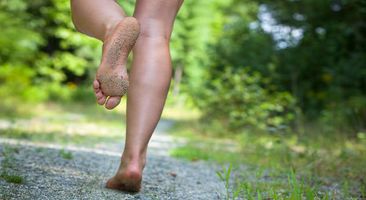Barefoot running
This article or area is currently under construction and may only be partially complete. Please come back soon to see the finished work!
Introduction:[edit | edit source]
Running has become increasingly popular over the years and provides numerous health benefits including improved cardiovascular health,decreased risk of stroke and hypertension, increased bone mass[1] and psychological benefits such as decreased depression and a positive effect on mood state. Despite its popularity and many benefits runners still experience a high injury rate,with up to 79 % of runners incurring an injury annually[2].Thus, runners have sought numerous strategies in hopes of reducing injury and running faster. One strategy is to run without any shoes at all:Bare foot[3]
Despite the benefits of footwear, interest in barefoot running has increased among the running community, with proposed benefits including a decreased injury rate. Advocates tout the evolutionary success of man as a barefoot bipedal runner. There is also speculation that the development of modern footwear and the associated altered running gait patterns (including a hindfoot strike versus the forefoot or midfoot strike typical of unshod runners) have contributed to injuries seen in runners[4].
Humans are maladapted to wearing shoes in some ways that contribute to certain injuries. From an evolutional medical perspective, three novel consequences of wearing shoes may be relevant to injury :[5]
- Shoes limit proprioception: Sensory feedback from the plantar surface of the foot works as an adaptation for sensing characteristics of the ground including hardness, roughness, unevenness, and the presence of potentially dangerous objects such as sharp rocks. Plantar proprioception activates reflexes and helps the central nervous system make decisions that help increase stability and avoid injury.
- Modern shoes with elevated heels, stiff soles, cushioning, and arch support may either facilitate or encourage a different running form than appears to be common among habitual barefoot runners.
- Shoes can contribute to weak and inflexible feet, especially during childhood when the foot is growing.[5]
WHAT DO WE KNOW ABOUT BAREFOOT RUNNING?[5][edit | edit source]
Most studies of barefoot running were conducted by asking habitually shod runners to take their shoes off in a laboratory.However,using only habitually shod runners to study barefoot running is problematic because one cannot expect such subjects to have developed the musculoskeletal adaptations and kinematic habits of habitual barefoot runners.Barefoot runners have more variable kinematics than shod runners because they experience more proprioception from their feet.It is also important to emphasize that all runners, barefoot and shod, vary in their form depending on a wide range of conditions such as speed, surface texture, surface hardness, and fatigue.
Foot Strike patterns in barefoot and shod runners:[edit | edit source]
- Barefootrunners often land on the fore-foot (fore-foot strike) before bringing down the heel, but they sometimes land with a flat foot (mid-foot strike) or, less often, on the heel (rear-foot strike).However.shod runners mostly rear-foot strike,due to the elevated and cushioned heel of the modern running shoe.Kinematic and kinetic analyses show that even on hard surfaces, barefoot runners who fore-foot strike generate smaller collision forces than shod rear-foot strikers.Fore-foot- and mid-foot-strike gaits were probably more common when humans ran barefoot or in minimal shoes, and may protect the feet and lower limbs from some of the impact-related injuries now experienced by a high percentage of runners[6].
- Shorter stride length and high stride frequency.[7]
References:[edit | edit source]
- ↑ Wilks DC, Winwood K, Gilliver SF, Kwiet A, Chatfield M, Michaelis I, Sun LW, Ferretti JL, Sargeant AJ, Felsenberg D, Rittweger J. Bone mass and geometry of the tibia and the radius of master sprinters, middle and long distance runners, race-walkers and sedentary control participants: a pQCT study. Bone. 2009 Jul 1;45(1):91-7.
- ↑ Hreljac AL, Marshall RN, Hume PA. Evaluation of lower extremity overuse injury potential in runners. Medicine & Science in Sports & Exercise. 2000 Sep 1;32(9):1635-41.
- ↑ Hanson NJ, Berg K, Deka P, Meendering JR, Ryan C. Oxygen cost of running barefoot vs. running shod. International journal of sports medicine. 2011 Jun 1;32(6):401.
- ↑ Giuliani J, Masini B, Alitz C, Owens LB. Barefoot-simulating footwear associated with metatarsal stress injury in 2 runners. Orthopedics. 2011 Jul 1;34(7):e320-3.
- ↑ 5.0 5.1 5.2 Altman AR, Davis IS. Barefoot running: biomechanics and implications for running injuries. Current sports medicine reports. 2012 Sep 1;11(5):244-50.
- ↑ Lieberman DE, Venkadesan M, Werbel WA, Daoud AI, D’andrea S, Davis IS, Mang’Eni RO, Pitsiladis Y. Foot strike patterns and collision forces in habitually barefoot versus shod runners. Nature. 2010 Jan;463(7280):531.
- ↑ Squadrone R, Gallozzi C. Biomechanical and physiological comparison of barefoot and two shod conditions in experienced barefoot runners. J Sports Med Phys Fitness. 2009 Mar 1;49(1):6-13.







